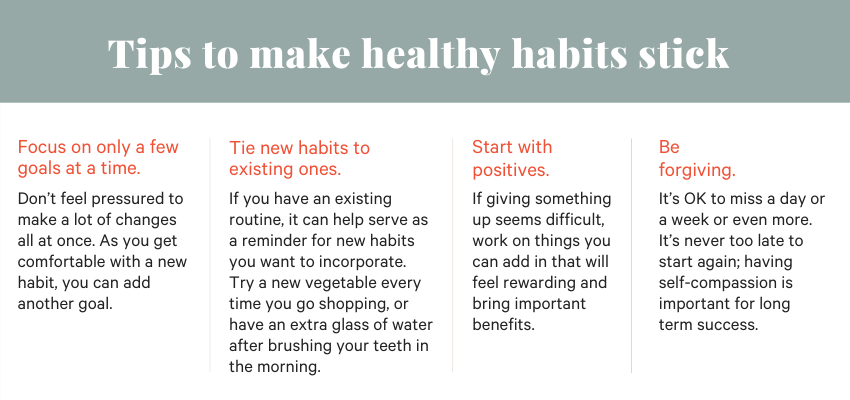Healthy eating habits you can start right now
- 01/21/21
There are many ways to make healthier food choices, but it can be hard to know where to start. The internet is full of nutrition blogs, influencers promoting diets, and other information that can be intimidating for someone who wants to find healthier ways to eat.
We spoke to cancer nutrition and fitness expert Stacy Kennedy, MPH, RD, CSO, LDN, CPT, about what you can do if you’ve just resolved to start a healthier diet. She recommends simple changes to make your meals and snacks more nutritious and enjoyable so your resolutions become long-term habits.

Add fruits and vegetables
Eat your veggies is old advice, but it’s important and doesn’t have to feel like a chore. Stacy recommends having about two fruits and at least three vegetables every day.
There are lots of ways to work vegetables into meals you already like. Try adding frozen, riced cauliflower or sautéed mushrooms to recipes like turkey meatballs or turkey chili to add nutrients and cut down on red meat. Plan for an easy sheet pan meal by roasting chicken or fish with any vegetables that you enjoy, like broccoli or green beans.
Stacy recommends cruciferous vegetables for people who have been diagnosed with breast cancer. “That whole family of vegetables is healthy for our liver, and when we look at research on nutrition and breast cancer, it’s a family of vegetables that has some particular benefits,” she says.
Cruciferous vegetables include:
- Cabbage
- Kale
- Collard greens
- Mustard greens
- Broccoli
- Arugula
- Brussels sprouts
- Cauliflower
- Radishes
- Turnip
- Rutabaga
Plants, any way you want them
Studies have repeatedly shown that adding fruits and vegetables to your diet is associated with better health outcomes, Stacy says. It’s common to find stories on the internet that warn of hidden dangers, especially sugar, hiding in specific fruits and vegetables. Stacy says this information is false and can be misleading.
Stacy says to go for frozen options, especially in the off season. Frozen produce has as much, and sometimes more, nutrients than fresh. Frozen may be easier for you to store, especially if fresh veggies tend to go bad before you are able to eat them.
Set aside time to plan meals
A good way to stick with healthy habits is to think ahead. Stacy says you don’t have to map everything out at once. “Even if you plan three breakfasts and three dinners, you can easily create leftovers for lunch; it’s a great way to get started,” she says. Planning meals can also help manage your budget and reduce food waste.
Stacy recommends setting a consistent time each week to plan your meals. You can tie this to something you already do, maybe before watching a favorite show one weekday evening or after reading the Sunday news.
Stop eating after dinner
There are many different versions of this advice, some say to stop eating at 9 p.m., others say 7 p.m. Stacy says the specific time of day isn’t really the important thing, the goal is to cut out evening snacking and to give your body time to digest, rest, and repair overnight. Enjoy a delicious, nutrient-dense meal, then close the kitchen until morning.
There are times when an evening snack may be helpful. Anyone suffering from treatment-related nausea or those who eat a very early dinner may find a light, protein-rich snack later in the evening staves off symptoms, but try to avoid sugary and processed snacks that you reach for on a whim. Sipping on herbal, caffeine-free tea is a simple evening habit to replace snacking, and that introduces antioxidants and other benefits of tea.
Drink water
Drinking water is a popular tip for healthy eating, and for good reason.
“Hydration isn’t the most exciting thing to recommend, but it’s really important,” Stacy says. “We need water for our metabolism to work properly, plus for energy to overcome fatigue.”
If you need help remembering to drink enough water, there are options, like setting alarms on your phone. Everybody’s hydration needs are different, but aiming for the standard advice of eight cups of water a day is a good place to start.
Talk to your doctor about vitamin D
Stacy recommends speaking to your doctor about testing the levels of vitamin D in your blood, to see if you need a supplement. Having low levels of vitamin D is a common issue and the amount you get from food may not be enough, especially in winter when there isn’t much direct sunlight, our main source of vitamin D.
“We want to go for food first, in general, but if someone has a deficiency, your doctor’s probably going to want you to take a supplement to correct that,” Stacy says.
Cut back on sugar and alcohol
If you are ready to cut unhealthy foods from your diet, Stacy recommends starting with sugar and alcohol. Alcohol and sugar have been identified as risk factors for breast cancer and other chronic health conditions, when consumed in excess.
For people looking to cut back alcohol, “Dry January” is a popular trend and Stacy says it can be helpful to take a break from alcohol, even if you do bring occasional alcohol use back into your life later. To better your chance of success, Stacy says to think about why you drink and make sure you find something to do in its place. If you have a drink because you feel stressed, you can try exercising, which reduces stress and is associated with a lower risk of cancer returning. Mindfulness meditation and yoga are also good ways to manage stress and are excellent evening activities, when you might be tempted to have a drink.
Stacy says there are fun, nonalcoholic options available, too. You can find a variety of sparkling, carbonated drinks at your grocery store and recipes for “mocktails” online for an evening treat or for a virtual happy hour.
For sugar, Stacy reiterates that the main thing is to cut out added sugars, the refined sugars that are in sodas, candy, cookies, ice cream, and other flavored or processed foods, and not to stress about the sugars that are natural in fruits and vegetables.
Be on the lookout for hidden sugars, found in flavoring and additives to foods like dressings, sauces, yogurt, granola, cereals, and instant oatmeal. She recommends buying plain varieties and adding your own flavor with fruit, pumpkin, nuts, seeds, or a natural sweetener — in a small amount — like a drizzle of honey, maple syrup, or molasses.
If you are interested in learning more, Stacy Kennedy MPH, RD, CSO, LDN, CPT, offers online courses that help you navigate fad diets and myths, courses to help manage symptoms and side effects with healthy eating, superfood cookbooks, and more. Visit Cancer Nutrition Training Center for more information. Use code LBBC21 at checkout for a limited time, 10 percent discount. You can also follow Stacy at @stacykennedyrd on Instagram.


